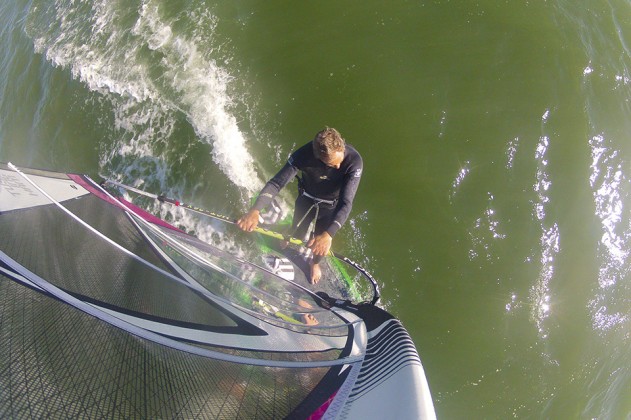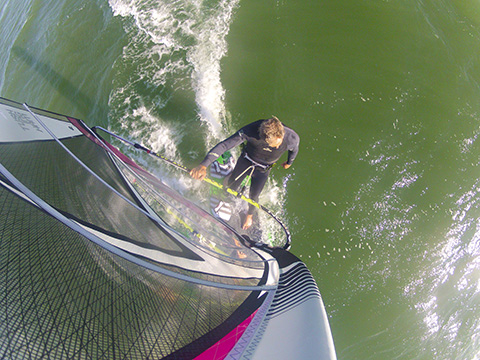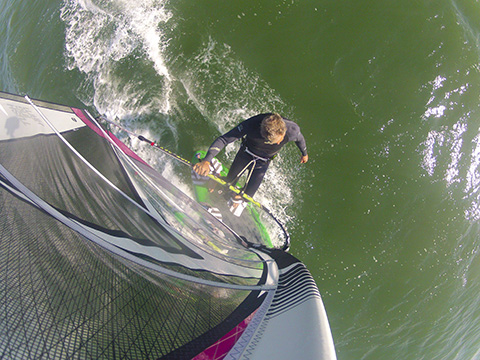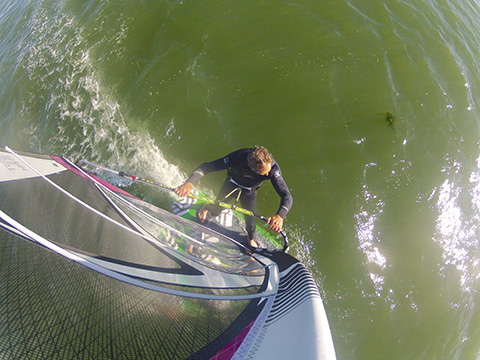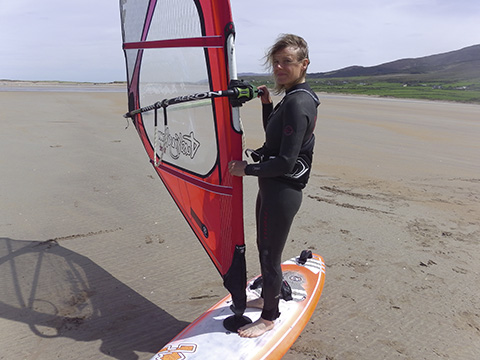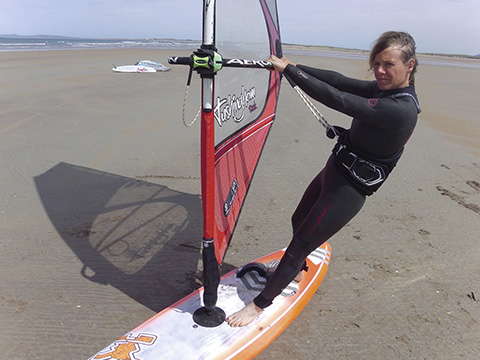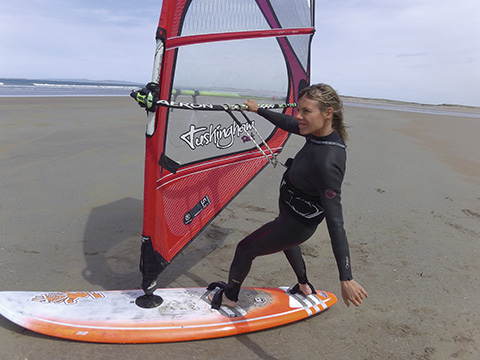Peter Hart Up and Riding in a Flash
Getting up and going is not just a ‘tick the box’ skill – it’s one that should be refined and adapted all the way through a windy career. Peter Hart reveals the fundamentals of early planing.
Right, before we go any further with this subject, lets get the weight issue out of the way. At the very mention of early planing, I wager those of you with fuller figures are throwing your arms in frustration, cursing your genetic disadvantage. I mean it’s simple physics isn’t it? A big thing needs more power to make it move than a little thing.
Hence women, children and scrawny blokes fly around in a fart while you wallow. And so it is you sail like a big person and sit there like a sack of potatoes waiting for the next hurricane gust to shift you. And I should know, because I was (and still am) that big person.
When I started racing I’d throw the towel in the moment the wind dropped below about 15 knots and watch stick insects like Barrie Edgington twinkle towards the horizon. It wasn’t until I started doing a few World Cup races and witnessed 95 kg. man mountain Bjoern Dunkerbeck turbo boost off the line ahead of the flyweights, that I understood that bulk is just an excuse for poor technique or a lack of effort.
Weight, of course, is a factor (in fact it’s the topic of the back page) but shedding kilos is a long term project. It’s not going to happen overnight. So lets focus on the early planing factors you can influence here and now. For a start we need to define what we mean by ‘early planing.’ It’s not just a contest to get going in the lowest wind strength. Whatever the wind, force 3-10, whatever the kit, raceboard or 60L wave board, it’s about how quickly you accelerate, how quickly you get into the straps and release; how much sail you need to do it. (And by the way, big people take heart that the flyweights often aren’t as good at early planing as their larger cousins because they don’t have to be. They’re usually sailing bigger boards relative to their weight so can just get in the straps sheet in and get blown along.)
If you cut the time it takes you to plane AND the amount of power you need to plane, ALL aspects of your windsurfing WILL improve
WHY?
It wouldn’t be unreasonable to say that early planing is the cornerstone of windsurfing. There are so many reasons to be good at it.
Energy saver. The most tiring place to be is in a state of semi planing in planing winds because there’s so much drag going through body and arms.
More control. If you don’t have to rely on enormous kit to get you planing, you have better control in tacks and gybes.
More practice. Apologies for stating the bleeding obvious, but you can’t practise planing moves unless you’re on the plane. So much of so many sessions are wasted because people aren’t able to make use of every gust.
New Skool. Moving up the scale, freestyle moves, especially those from the new ‘skool’ of derring-do, are only really achievable with sails under 6.0 (and preferably a lot less than that) – and you need to be using that small sail in a relatively light force 4-5 wind. It sounds brutal, but freestyle if off limits to those who can’t get planing with small sails.
The same goes for wavesailing. Big rigs in the surf limit your manoeuvrability and they break.
Better, more frequent jumps. The number one reason for floppy jumps is that people aren’t planing where the ramps are. In typical beach break conditions you need to be up to full speed by the time you meet the first barrage.
Better Racer. Part time or Olympic – acceleration onto the plane is a more potent racing weapon than top speed.
More security, less falls. The most precarious place to be is in ‘mid something.’ Mid tack, mid gybe, mid ‘Kabikuchi’, that’s where you’re going to lose it. It’s same with early planing. The longer you spend not quite planing with the board grinding through the water rocking from edge to edge, the more likely you are to catch a heel on the chop and catapult. And if it’s taking you an age to find the straps, you’ll look down and that will be when you get smacked by the unseen gust.
A badly tuned car uses a lot more gas that a tuned one. Those slow to plane are wasting a lot of energy and hence need more of it in the form of more sail and more volume
UNDERSTANDING THE CHALLENGE
To plane, a board – or boat for that matter – has to overtake its own bow wave. Smaller boards – and boards with a steep rocker line – push more water in front of them and so need more power to drive them up and over. A board needs more power to make it plane than it does to keep it on the plane. It’s like an over-laden speed boat. To start off it’s full throttle, props churning a massive wake, passengers running to the front, carbon footprint growing by the second until finally it climbs over the watery wall. But then as it releases and glides effortlessly (although still a bit noisily) you can throttle right back. If you hook into a 120L freeride board with a 7.5 sail across the wind and do nothing, you’ll need about 18 knots of wind to drive it onto the plane. But when you’re on the plane, you’ll only need 10 knots to keep it there. So to get on the plane in less than 18 knots, you have to do something to create an artificial surge of power. Pumping is one way but by no means the only one. As David Brailsford, Olympic cycling coach, famously stated, their multiple successes came from the ‘aggregation of marginal gains.’ It’s the same deal with planing. A lot of small adjustments can amount to a big advantage. But it has to start with the kit. The ramifications of kit choice and tuning are so vast, that I hope you’ll excuse me if I just hone in on a few specific areas that seem to make the biggest difference to the most amount of people.
A TRUE LITMUS TEST
Early planing tests every aspect of your game. You have to select and tune the kit to an optimum level. You have to read the conditions and coincide your effort with a gust and down slope. It demands a level of fitness. Tight limbs and a solid core are needed to transfer the power directly into the board. In strong winds especially you have to be committed and bit brave. And of course it’s the ultimate test of your stance, power control and trimming skills.
THE MATCH
It seems that this whole conundrum could be sorted with one sentence: “take out a bigger rig.” And for the timorous, that may well be the answer. But it may have the opposite effect, especially if you can’t fully sheet in, or the rig over-powers the board.
On a 12-knot marginal day last week on the beach lay a 125L freerace board with an 8.5 and a similar 120L board with a 7.8. They were both set up well and the carbon content of the hardware was similar. Surprisingly perhaps, the smaller combo planed earlier because board and rig felt a better match. It just slipped onto the plane. Both the 7.8 and the 8.5 rigs fell within their board’s recommended range. However the 8.5 was on the limit for the 130. The ends of the scale are rarely the sizes that work the best.
DRIVE & RELEASE
There are many personal, quirky techniques to help planing like rocking the board from side to side to unstick it, hoofing the fin, shaking the sail to get the air moving etc. Ultimately you’re trying to bounce it onto its planing surface by driving it into the water with rig and foot pressure – and then releasing it. Letting go of the front hand off the boom, as well as being mildly cool, stops you choking the rig and forces you to extend away and drop the hips behind the feet.
// The toes of the front foot press down on the sweet spot of the board just in front of the entry to the rocker. The friction creates lift. The board pushes back against the foot…
// …so as you release it, it pops up and onto the plane. Because the hips are right back, putting the front foot in the strap is just a case of tucking it under your knee.
MATCHING HANDS & FEET
The feet will always try and match the hands. If you commit the cardinal sin of placing the front hand at the front of the boom, the front foot will move forward to keep balance and stop you heading up. But he’s now standing directly over his feet so his weight and all the power from the rig is acting down rather than forward. Planing is now a hurricane away. But if he moves the front hand back, the front foot will move back, the nose will rise and the board has a chance of releasing.
With the 8.5 it felt as if the advantage of the extra power was cancelled out by the extra dead weight, which made the board displace more water and create a bigger bow wave. It was crying out for the support of an extra 10L of volume. Water state also has a big influence. The day before, Irish Ned crawled from the water and declared that his rig, and I’ll quote his own vernacular, ‘felt utter sh**e.’ He was using his 5.7 on his favourite 80L wave board – a combo he loves on his windy, mostly flat, bump and jump patch back home. But in the onshore winds of Scraggane Bay it felt totally different. The relatively big rig was pushing the thin, soft rails deep into the chop and stopped it releasing – and that’s what made the rig feel heavy and ‘sh**e.’ He needed a bigger board. When we’re talking matches, so much depends on the design and, above all, the width of the board and the skill and weight of the sailor. However, in the disciplines where early planing is top of the list, e.g., marginal wind sailing, new school freestyle and wavesailing, a little extra board volume is a more potent weapon than a great tractor of a rig, especially now since bigger boards, of all categories, are so much more controllable. Smaller rigs are also easier to work and pump – more about that shortly.
THE RIGHT SORT OF POWER
I’m all for detailed rigging instructions, but if you’re to excel, there comes a time when you have to dump the fundamentalist scripture and trust your own feelings and instincts. If it doesn’t feel right and you ‘aint going, change something until you do. At risk of sounding like a train service spokesperson, you may have a lot of power, but it may be the wrong sort of power. You sheet in, the sail fills and pulls. Eskimos have 50 words for snow. Practised windsurfers should have 50 words to describe ‘pull.’ Was it a grunty pull? A draggy pull? A jerky pull – or a soft, springy pull? (Soft and springy is good.) If your chosen rig isn’t quite getting you there and you don’t want to/can’t change up, the received wisdom is to ‘bag it out’ by easing off the outhaul and/or the downhaul. More shape surely equals more power. But bag it too much and the sail turns from a foil to an umbrella. The skill is in tweaking and feeling whether the sail is powering you along or just driving the board under the water. My first adjustment is usually to ease off a centimetre of outhaul, which puts a bit more shape in the battens just above and below the boom, where most of the power is generated. If you let off too much to the point where there’s no tension in the back of the sail, on non-cambered sails particularly, the foil billows onto your back hand. With an unstable centre of effort it’s hard to pump effectively and deliver the power precisely into the board. And on boards with titchy fins the tail will keep breaking out. The downhaul needs to be handled with care. Easing it off a little, you put more shape into the top part of the sail and tighten the leech. That can be good. A tight leech is more reactive when you pump. But ease it off too much and the leech stays closed. The sail traps the wind but doesn’t release it. You sheet in, loads of pull, here we go … no we don’t. The sail keeps on pulling instead of softening and becoming lighter as you accelerate. Unless the wind can escape from the leech, you’ll get all the misery of being over-powered, aching muscles, blisters, but none of the joys – instant acceleration and speed. Brendan was out on his 6.0 yesterday. He was slow to get going despite easing off the downhaul. Actually it was because he eased off the downhaul. Big diagonal creases spread from the leech to the mast end of the battens – a sure sign that the leech is trying to open but can’t. Somehow it seems counter-intuitive to increase downhaul when you’re struggling to plane – but in this case an extra inch transformed the sail.
GET OUT THE STOPWATCH
The surest way to gauge progress is with a stopwatch, real or imagined. In a solid wind, time how long it takes you to get hooked in, strapped in and released fully onto the plane.
If it’s more than 5 seconds, there is work to be done.
THE MAST QUESTION
A last thought on kit: People ask whether the 100% carbon mast is worth it – or will the cheaper one do? With absolutely no support from the carbon growers association, I have to say it IS worth it, for the early planing alone. Power to plane doesn’t just come from a full belly. It comes from a reactive leech. When you sheet in and pump, the mast flexes and the leech opens and the wind exhausts. The lighter, full carbon mast returns more quickly, which allows you to pump faster and more often.
TWEAKING THE SET UP
This won’t last long. Ready. Put the boom up. That’s it. Don’t go silly. It has to be within the range that works, which for planing sailing on 70-cm-wide (ish) board is around nipple to shoulder height – a little higher for wider boards where the straps are further from the mastfoot. With a higher boom, you feel the balance of power shift from feet to mastfoot and the board lighten up. Looking for more power to plane, I put the boom up an inch and release a centimetre of outhaul. Nine times out of ten that does the trick. If it doesn’t, I’ll just hope the pubs are open. And my very last word on the set-up matter before we head to the far more important business of technique, concerns harness lines. The most efficient way to power up the sail and get planing is to use the harness. If the harness lines are short, you’ll drag the rig back as you move to the straps, depower the sail and sink the tail. If the lines are long, the rig stays forward and upright. You’ll power up the mastfoot and the board will stay level – your choice.
EARLY PLANING TECHNIQUE
The sign of a well-rounded windsurfer is being able to adapt her skill according to the kit, the conditions and the moment. For example, a good gyber will shape the arc of each turn depending on how powered up she is and what’s in front of her. The slick waterstarter employs a different rig recovery method depending how and where the rig is lying. It should be the same with early planing. The sequence and technique changes for different designs of board, light and strong winds, calm or rough seas. An obvious example is where someone moving from a big freeride board to a small waveboard tries to get going by sheeting in across the wind and hoofing against the fin. But for all the many variations, it’s best to approach the challenge with broad concepts and relate it to skills you already have.
THE BURST OF POWER
What gets you out of the water in the waterstarts is creating a sudden surge of power. To begin with, if it’s windy, you just bear away. Then you learn to bear AND extend from the shoulders to raise the rig. Then you start pumping as you come up and kick the front leg and time the effort with a gust and as a wave lifts you – until finally you’re popping up in a zephyr. It’s exactly the same with getting planing. You need a burst of power to overtake that bow wave and break free. Success comes with co-ordinating all your lift devices – kicking off the wind on a gust, sheeting in, tilting off down a slope, bouncing the board, working the rig – all pretty much at the same time. And back to waterstarting. When it doesn’t work, the thing absolutely not to do is hang there, arms raised high waiting for the next depression to pass through and blow you up. Instead you have to lower the rig again, head back upwind and create another burst. Trying to plane, if you bear away, go for it and it doesn’t happen, don’t tootle off downwind cursing your ill fate. Turn back upwind and look to explode again.
THINK LIKE A SMALL PERSON
May I crave your indulgence and ask you to imagine you’re water-skiing behind a dodgy, faltering powerboat off the coast of S. Africa. The rope has frayed so you’re being pulled by just one thread. You look behind to see a hungry Great White shark following you with intent. What would you do? Instinctively you would extend the arms, give to the power, come up on your toes, suck your guts up under your ribcage, make no jerky backwards movements against the rope and reduce the drag of the skis by riding them as flat as possible.
That’s early planing – in brief you’re trying to present the board to the water in such a way that it creates the east drag, whilst at the same time maximising the available power. But how do you do that?
SET UP CHECK
A few simple checks on the beach to give you the best chance of getting going with the least effort.
// Set the boom height to the top of the workable range, which for a wave board is around shoulder height.
// Place the board close to the wind and the lines should be long enough that you can hook in with the front foot by the mastfoot. But there’s a feeling of being slightly suspended in the harness with the weight coming off the feet.
// Then, in the straps the ultimate early planing test is that even when you move back into the straps, the set up allows you to stand tall on your toes and hold the rig upright.
LESS IS MORE – UNTIL MORE IS MORE
Coaching lower intermediates in the art of early planing I urge them to do less. Aspiring experts I encourage to do more. Less, in this case means keeping it all solid and constant, committing fully to the harness, holding the rig still and bearing away gradually to deliver a calm constantly increasing force into a level board. That opposed to gyrating hither and thither, on and off the power, rig flying all over the shop so the board surges and stops like a learner driver kangarooing down the street. More, means getting more active, in a good way. You keep the power on but add little surges to help unstick a reluctant board. We’re talking pumping. Pumping – sheeting in suddenly and releasing – is a controversial subject in that while it’s potentially the best way of releasing a board, done badly is also a way to make sure the board never planes ever. The way to introduce yourself into the feel and rhythm of pumping is to do it hooked in. Committed to the harness, the board gets a constant flow. Then give little pumps with the back hand. Every pump creates a surge, which you drive into the board with the toes and then release. It’s as you release the pressure that the board bounces up onto its planing surface. I don’t really want to talk about pumping as it’s like trying to describe juggling. It’s all about feel and timing. Other things are far more important.
Of all the important things that are the most important, this is the most important of all. The key to getting going is working within the wind angles that provide the useable power for that wind strength and the amount of sail you’re carrying. It’s bearing away into a gust that is your most effective weapon – but how much? In less wind you need to bear away more. In more wind you bear away less. Perhaps it’s easier to describe the effects of heading off on the wrong tack. In a marginal wind, if you don’t bear away enough, you just don’t generate the power to get going, simple. On a small board with a small fin, if you don’t bear way enough and start pumping, the surges of power are lateral and you’ll slip sideways. To pump effectively on any board, you have to bear away off the wind. Off the wind the pulses of power drive the board forward. In a strong wind, if you bear away too much, you can’t close the sail and get pulled too much over the board. At best the board lurches from edge to edge. At worst you get catapulted.
KNOWING YOUR BOARD – THE ENTRY POINT QUESTION
Crusty windies from another era have been bamboozled by the planing quirks of modern kit. Back in the day boards were up to 4m long and had a constant rocker line. To plane you made the long journey to the tail, via several sets of straps, stopping for tea and Kendall mint cake on the way, as the board gradually lifted out. To move back a moment to soon was to sink the narrow tail and stall immediately. Above all else you stayed forward. Today, many boards will not plane if you stand too far forward. On the shorter, racier models, the entry point, where the board first makes contact with the water, is only just in front of the straps. If you stand in front of it, you push a curved section of board into the water and stop it gliding. It’s a case of, get into the straps in order to plane. On your own board, feel for that entry point by playing around with the front foot position. A inch forward and back is critical to the trim.
EFFICIENT TRANSMISSION
And so to the body. It is the transmission. It takes the power from the engine and transmits it to the wheels. Ultimately it’s the vital link in the chain. The biggest change occurs though practice and confidence. It’s where people go from being blown on the plane thanks to big kit and a bit of luck with some local weather, to actually driving the board onto the plane. In the first instance, they just stand over their feet and the volume of the board sort of makes sense of the power. In the second, they drop their hips behind their feet, take the power from the sail, through a tight stomach into, the legs and actually slide the board forward.
You can get the same words plus actions from the horse’s mouth by joining Peter on one of his internationally acclaimed, game-changing clinics, catering for everyone from planing novice to jumping, riding fanatic. Lots of info about the 2015 schedule on www.peter-hart.com. And get regular updates by liking his Peter Hart Masterclass page.


